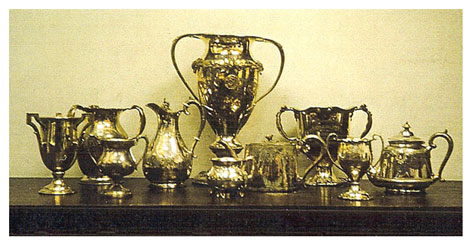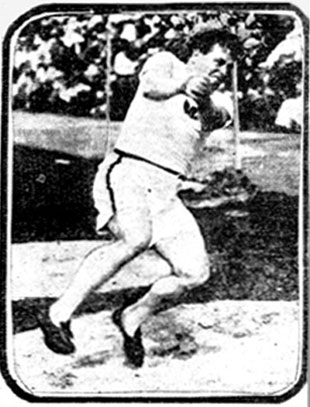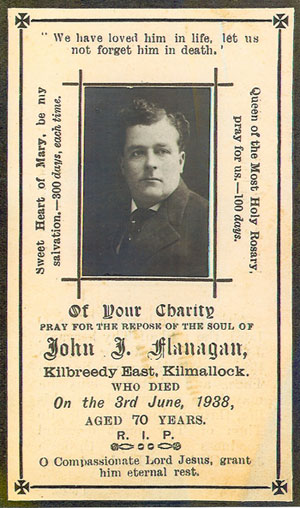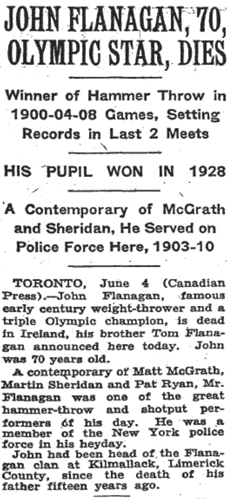All content on this site, unless otherwise specified, is © Copyright Ian McGowan / Winged Fist Organization. Web Design Conrad Landais
Considered the father of modern hammer throwing, and a modern-day Hercules, John Joseph Flanagan was born in the Kinkead home of his mother's family in the Parish of Knocklong/Glenbrohane, in Ballinvreena, in the District of Kilfinane, in the Union of Kilmallock. Flanagan competed in the 1900 Olympic Games in Paris as a member of the New York Athletic Club, and in the 1904 Olympic Games in St. Louis and the 1908 Olympic Games in London as a member of the Irish-American Athletic Club, winning three gold medals in the Hammer throw and one silver in the 56lbs. weight throw.
From 1895 to 1909, Flanagan raised the world's record in the 16lbs. hammer throw in sixteen installments. He served with the New York City Police Department from 1902 to 1910, when he retiurned to Ireland. He died June 3th, 1938 on the family farm in Kilmallock, Co. Limerick, Ireland.
* (While Flanagan's middle name is widely reported as “Jesus,” according to his family, his middle name was actually Joseph, a common name in the Flanagan clan).
The following article is excerpted from Champions of the Athletic Arena, by William Dooley, published in 1946.
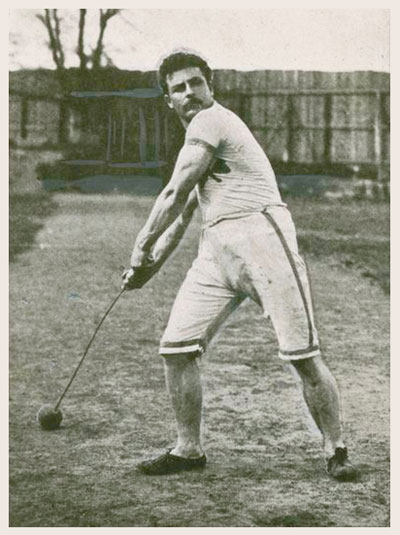
Different authorities have stated that the height of the hammer-throwing wonder, John Flanagan, was 5’ 9 ½”, but his own statement is that he stood 5’ 10 ½”. Born at Kilbreedy, Kilmallock, he came under early notice as a prize-winner at Emly in 1891, and his first title came three years later, a Munster 56lbs. event, at Waterford R.I.C. Sports.
In August, 1895, on the historical day when James J. Ryan broke the high jump record, John negotiated 22’ in the long jump as a close-up second to Larry Roche of Bruree, and cleared over 46’ in the hop, step and jump as second to Ryan. His first notable hammer win was accomplished here for he beat Denis Carey. In September he was second in the G.A.A. all-around Championship, to Tom Wood of Enniskean, Cork, at Clonmel, with 11 points to spare over Mike Ryan of Rockwell, famous Rugby man.
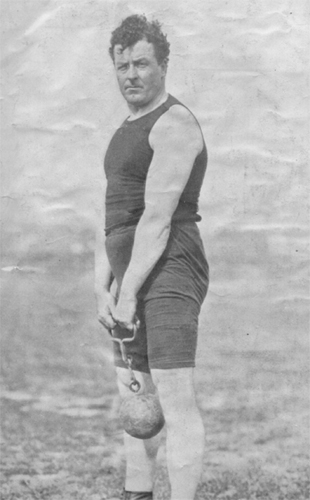
In April, 1896, at the Gaelic Sports, Stamford Bridge, he broke two world hammer records, beating, by 2ft., Jim Mitchell’s recognized best of 145’ ¾” from a 7’ circle. In May he brought world figures in the unlimited run and follow mode over 156’ at Kensal Rise, London, and, in July, took the British crown from a 9’ circle.
Flanagan emigrated a few months afterwards. His initial encounter with Mitchell was in the New York Senior Metropolitan Championships, in Columbia Oval, in August, 1897, Mitchell suffering his only Championship defeat in 8 years. John taking the hammer throw at just over 149’, and going ahead to win the American title in late August at some inches less. He then travelled to the Canadian Championships, at Toronto, and put up a Dominion record 9ft. better than the one existing in Mitchell’s name, also taking 56lbs. laurels.
John won the Olympic hammer throw at Paris in 1900, with 167’ 4”, crossed over to take the British crown at 163’ 5” at Kilmallock, all of these marks being far in advance of anything shown by his contemporaries.
At Celtic Park, New York, in September, 1901, he brought the hammer record to 171’ 9” and in October, made world discus best, 124’, at Louisville, Kentucky. Before the end of that month, we find him at the Irish-American (Athletic Club) Games, New York, blotting out Mitchell’s 56lbs. figures from a circle with both hands, at 36’ 9 ½”.
On 31st July, 1904, he reached 173’ with the hammer and won his second Olympic title at St. Louis, doing 168’ 1”.
John’s best accepted 56lbs. throw from a 7’ circle was that given in winning the American Championship of 1907, at Jamestown, 38’ 8”, and here he also best 171’ in taking the hammer event.
Matt McGrath was now coming to the fore and he beat John in the Fall of 1907 at over 170’ and the inclusion of both on the American team for the London (Olympic) Games, 1908, made for a great struggle for mastery. Matt led into the final at Sheppard’s Bush, with a throw of 167’ 11”, but John came out in the concluding rounds to win at 170’ 4 ½”, a fresh Olympic record and his third consecutive win. Again visiting this country (Ireland), he flung a 56lbs. 39’ 2½” and the hammer 179’ 10”, each from a 9’ circle, which figures are still on our books.
The battle of the giants between Flanagan and McGrath went on anew on their return to the New World. Their titanic struggles were the high lights of the period. Matt took the American Championship, at Travers Island, and John the New York Senior, by a foot, at over 172’. McGrath had, by now, erased John’s world record, by inches, but, on their tenth meeting of 1908, Flanagan regained the best figures with 174’ 4 ¾”, at the Fall Games of the Irish-American A.C.
The arrival of Con Walsh of Carriganima, Macroom, (Co. Cork, Ireland) in the United States, made the competition sterner still. In June, 1909, Flanagan threw an unprecedented 174’ 10” but was unable, at this, to concede a 10ft handicap to Walsh who beat 165’. At Celtic Park, also in that month, John beat 174’ against a breeze, with McGrath just 2 ½” away, but John had a convincing win over Walsh and McGrath, at American League Park, when he became the first human to ever reach the classical 180’ with a regulation 16lbs. hammer. His crowning achievement came, however, at the Clan-na-Gael Games, Newhaven, on 24th July, 1909, when he threw 184’ 4”.
Joining the New York City Police he was declared No. 1 physical specimen of 1,200 applicants. He definitely placed hammer-throwing on the map, adding more than 37ft. to his earliest record during a period of 13 years. He came home to reside in his native place in 1910, and died there in 1938.
Flanagan’s style was a treat to look upon and many of the aristocrats on Fifth Avenue were in the habit of visiting Travers Island and other New York venues to see John, and John alone, pivoting in the circle. Although Alfred Plaw of California was the man who started the three-turn method of throwing a hammer, he was actually unaware of the fact, as he employed it in a rather crude form, but John seeing him in the circle, at once saw its great possibilities, and brought it to perfection. Prior to the advent of the Germans, sound judges of form described him as “the greatest hammer-man, of his inches and poundage, that ever lived.”
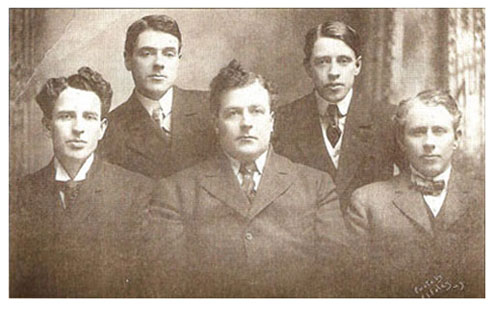
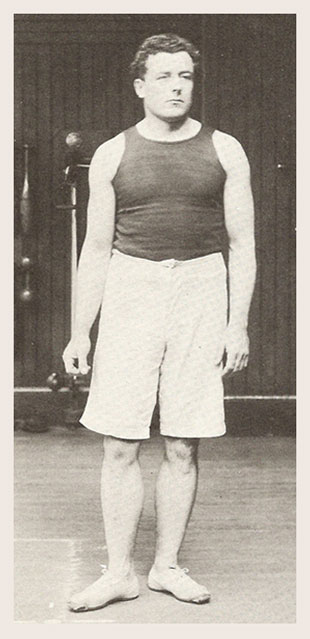
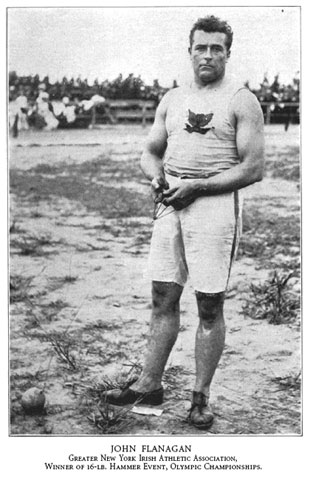
1900 Olympics, Paris:
Hammer throw – Gold
1904 Olympics, St. Louis:
Hammer throw – Gold
56lbs. weight throw – Gold
1908 Olympics, London:
Hammer throw – Gold
